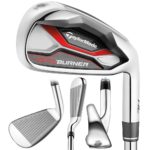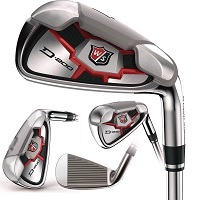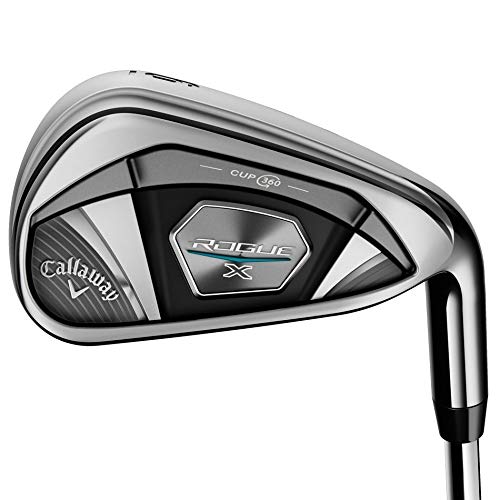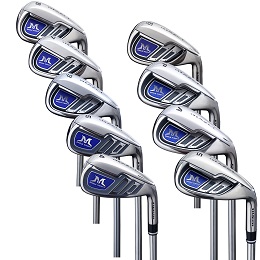Most Forgiving Irons – Beginners Sets
People can forgive….
But a golf club? Really?
When a golfer describes a golf iron as forgiving what is meant is that the club can help compensate for some minor swing errors.
It means that a forgiving club can still produce a decent shot – even when the golfer doesn’t make solid contact with the golf ball. Below we’ll discuss more of the aspects of a forgiving golf iron, but just in case you are in a hurry, here is the GUIDE:
MOST FORGIVING IRONS – COMPLETE SETS
| Image | Description |
|---|---|
 |
Model: Callaway Golf Men’s X-Series Irons
Overview: The X-Series Irons from Callaway are an excellent choice for a golfer of almost any skill level. These irons are the epitome of what a forgiving iron design should be. Starting with their very low center-of-gravity (CG), which is accomplished through the extra-wide (and weighted) sole, these irons can actually help increase swing speed and, as a result, distance. The X-Series irons have a deep cavity back design and perimeter weighting – both are important design features that help increase flex and minimize rotation at impact, thus making these X-Series Irons very forgiving, Set Contains: 4 Iron through PW and SW Shaft Material: Steel BGST Forgiveness Rating: 4.8/5.0 |
| |
|
 |
Model: TaylorMade AeroBurner HL Irons Overview: These Taylormade AeroBurner HL (High-Loft) Irons are all about forgiveness. These irons come with a patented SpeedPocket in the sole, like the RSi irons before them. This SpeedPocket helps keep consistent club head speed throughout the bottom of the swing by enhancing the low center-of-gravity (CG) strikes. These clubs have a very high Moment of Inertia (MOI), which is a club’s resistance to twisting. A golf club’s MOI provides a reliable measure of forgiveness – the higher the Moment of Inertia the more forgiving the club is said to be. The AeroBurner HL irons also use the type of perimeter weighted design that increases the size of the sweet spot, These clubs also have have optimize lofts to help beginners get the golf ball in the air quickly and maintain a high trajectory ball flight. Set Contains: 4 Iron through PW and AW (Approach Wedge/Gap Wedge) Shaft Material: Steel BGST Forgiveness Rating: 4.6/5.0 |
 |
Model: Wilson Staff D200 Irons Overview: The D200 Irons from Wilson Golf feature SPEED SOLE TECHNOLOGY, which creates a very smooth, very thin face-to-sole transition. This accomplishes several things that make these Wilson D200 irons very forgiving. First, this thin face-to-sole design enhances the flex of the club face at impact. Irons that flex help compensate for mis-hits. These irons also feature heel and toe weight pods that help to provide a larger sweet spot and more forgiveness. A satin finish on these weight pods show where the weight is positioned on the exterior of the club head. These clubs also have an extra-wide (and weighted) sole, which creates a nice, low, center-of-gravity (CG) that can actually help increase swing speed and distance. Set Contains: 4 Iron through PW and SW Shaft Material: Steel BGST Forgiveness Rating: 4.4/5.0 |
 |
Model: Callaway Rogue X Irons (2018) Overview: Another new irons set for 2018 from Callaway Golf, the Rogue X Irons are similar to the X-Series Irons profiled above, but with the advanced Rogue technology that has made the Callaway Rogue Driver the most forgiving driver of 2018. These Rogue-X irons come with 360 Face Cup Technology, which they say is the thinnest face Callaway has ever produced. These irons are a little more about speed than forgiveness and their shallower loft angles are why I didn’t rate these clubs higher for this most forgiving irons review. These irons impart less spin, which increases roll-out (and distance), but can make them more difficult to stop on the greens. The Rogue Technology, however, does increase the Moment of Inertia (MOI) of these clubs to a ridiculous level and probably makes them the easiest irons for beginners and high handicappers to hit straight. Set Contains: 4 Iron through 9 Iron, PW Shaft Material: Steel BGST Forgiveness Rating: 4.3/5.0 |
 |
Model: Mazel Same Length Irons Overview: These Mazel Same Length Irons may not be the most popular golf irons on the market, but are an excellent choice for beginners who are looking for a forgiving set of irons at a reasonable price. Each single length iron is 37.5 inches and provides the same swing weight and consistent feel for every shot, no matter which club you pull. Mazel irons are all made from stainless steel and feature a combination of a large sweet spot for improved accuracy and low Center-of-Gravity (CG) that helps beginners or golfers with slower swing speeds to fly the ball straighter and longer. Each club has a high performance rubber grip that offers a consistent feel and shock absorption through the shaft and to the grip. These Mazel Irons also have a deep cavity back design and perimeter weighting – all of which makes these extremely forgiving irons. Set Contains: 4 Iron through 9 Iron, PW, AW and SW Shaft Material: Steel BGST Forgiveness Rating: 4.2/5.0 |
What Makes An Iron Forgiving?
Above, we were discussing how a forgiving iron can compensate for some of a golfer’s swing errors. These swing errors can fall into a range of different categories, but in general a swing error is anything that a player does during his or her swing that results in the club face making less-than-ideal contact with the golf ball. The more ‘forgiving’ a club, the ‘less perfect’ that contact between the club face and the ball has to be to still produce a reasonable shot.
Since many players – especially beginners – seem to have difficulty when learning how to properly hit their irons finding and playing the most forgiving irons on the market is something that can help many beginning golfers improve their game immediately.
Let’s take a deeper look at what it is exactly that can make one type of golf iron more forgiving than another.
What Makes One Iron More Forgiving than Another?
This all boils down to the technological advances in golf club design that have been implemented to overcome the exact swing flaws that the majority of players exhibit. Lets look at some common flaws that beginning iron players make and then we’ll talk about the specific advances in golf iron design that have been implemented to overcome those flaws.
The first ‘flaw’ that some beginners have when learning to hit their irons better is a club head speed that is too slow to create the lofting arc associated with a good iron shot. Simply, if the player does not generate a fast enough club head speed, it is going to be more difficult to get the ball in the air and to get the proper distance.
To combat this, some companies are now producing irons with a very low center of gravity (CG). These irons are weighted more heavily in the bottom portion (or sole) to assist the club head coming through the golf ball. This lower CG helps produce a more penetrating (i.e. read ‘better”) trajectory – even at slower swing speeds.
The next problem to tackle was that of ‘off-center’ hits. Many different clubs are said to have a sweet spot – the area on the club face that when it comes in contact with the golf ball produces the straightest, truest, most consistent golf shots.
Beginners and intermediate players don’t necessarily make the most consistent ball contact from swing to swing. As a result, recent innovations in golf club design have called for irons to be designed with an undercut cavity. This undercut cavity is basically an area of empty space behind the clubface. This ‘cavity’ improves club head stability on off-center hits so that the ball will still travel in the direction the player was aiming – even with less-than-perfect ball contact – even when the player does not find the sweet spot.
Since beginners tend to produce slower swing speeds, the most forgiving irons have also incorporated design changes to the face of these clubs. Thin, energy-efficient faces increase ball speeds – even at slower club head speeds. One of the most forgiving iron designs on the market today is the state-of-the-art design of the
What else can beginners do to improve their iron play?
While using golf irons that incorporate the latest in ‘forgiveness technology’ is certainly one way beginners can improve their iron game, there are some less expensive ways beginning golfers can help mid-range game, as well. As mentioned above, one flaw that these new iron designs help to overcome is a slower club head speed. Learning how to increase club head speed is one way to improve the results a player can get when using his or her irons.
Another educational tool beginning iron players should take advantage of is an e-course called the 6 Step Golf Lesson with excellent swing training from the coach of Rory McIlroy. This is a complete series of educational golf videos online that focuses on just about every aspect of iron play, including the best swing to use with golf irons, how to address the ball when using one of the irons, and the proper stance, grip, and feel for optimizing iron play from the long irons all the way down to the short game.
Conclusion
So when evaluating irons to determine forgiveness, make sure to examine the weighting (i.e. center of gravity – CG), stability of the club head throughout the swing, Moment of Inertia (MOI), and club face material.
Rest assured, however that all of the most forgiving irons presented above have incorporated all of these attributes to make them among the easiest-to-hit irons available on the market today. Between the new technology in club face design and the optimum shafts these irons can help beginners and intermediate golfers overcome any inconsistencies in their swing and and produce more consistent ball flights and results.



